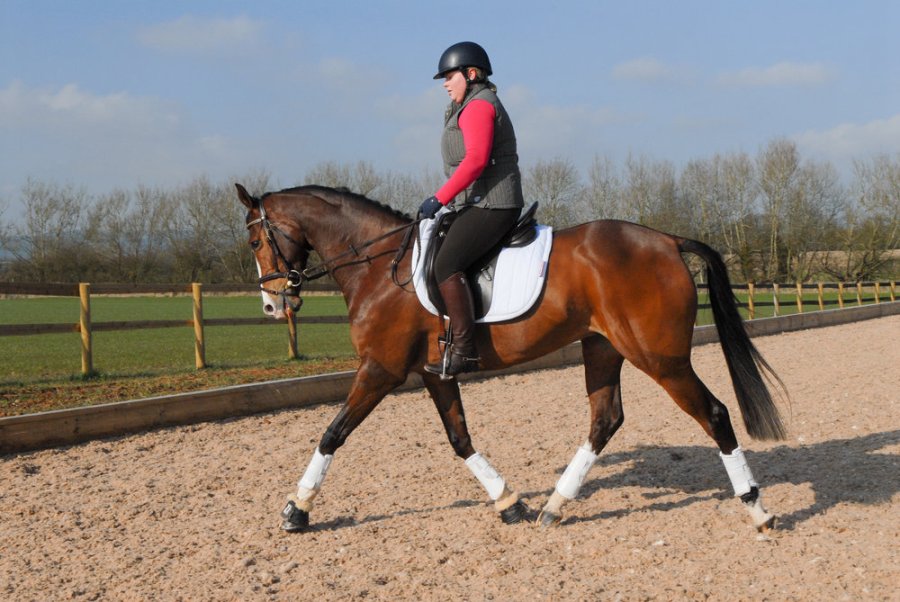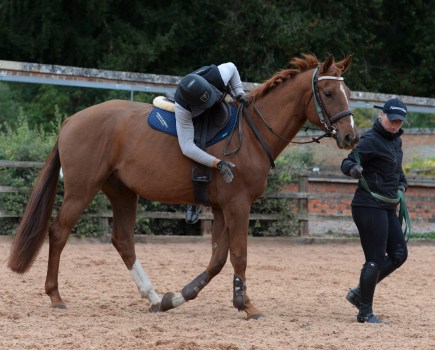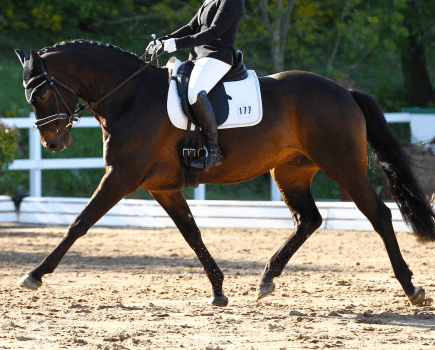Have you ever picked up your dressage sheet at the end of a competition and read the words: ‘losing rhythm on the turn’, ‘lacking rhythm in the medium trot’, ‘loss of rhythm on canter circle’ or something similar? Don’t worry, you’re not alone. Many riders struggle with rhythm, but there are some simple exercises that you can do to improve it.
Acclaimed coaches Ian and Heidi Woodhead explain why rhythm is vital to you and your horse’s performance.
What is rhythm?
The word ‘rhythm’ is derived from the Greek word rhythmos which means ‘measured motion’. You could also describe rhythm as the regular occurrence, or timing, of a beat. In equestrian terms it relates to the regularity of footfall in any pace.
If your test sheet says you’re ‘losing rhythm in trot through a turn’, it may be because your horse slows down or backs off your leg as you ride the turn, such as might occur on a serpentine loop perhaps.
If you lose rhythm in a medium trot movement, it could be that you’re pushing your horse out of their natural rhythm for their stage of training and development. We all know how it feels when our horse is running forwards and they miss a beat in trot, which often results in them running into a canter transition. Sometimes you just need to allow them to develop and strengthen physically and in their training experience in order for them to be able to hold rhythm in a change of pace.
Referring back to the original definition of rhythm as ‘measured motion’, this relates to each step – in any pace – being of equal length. In order to achieve this, the horse needs to be in balance and self-carriage.
Horses develop their strength through progressive training and, as they strengthen, they therefore improve in their ability to carry themselves in more complex movements.
Rhythm for equestrians
If the horse is truly in front of the rider’s leg, and they are submissive to the contact and level down the rein and through the topline, then they will travel in their own natural rhythm that they were born to go in, and the rider should be able to sit still.
Making sure that your horse is truly in front of the leg doesn’t mean that there should be an increase in speed. In fact, it’s important that the paces don’t quicken. In front of the leg means that if the rider applies a leg aid, the horse reacts in a positive, forward-thinking way. On the whole, riders need to work to improve the reaction that their horse gives when a leg aid is applied.
Submissive to the contact and level down the rein refers to the feeling that the rider gets from the horse through the reins. The horse shouldn’t be stronger on one rein than the other, and they should respond to the rider’s aids through the rein when the aid is applied.
Exercise 1: Achieving natural rhythm
A simple starting point to work towards achieving these aims is to train your horse to move away from your leg.
Start with the basics – a simple halt-walk, halt-walk exercise.
Tips for success:
- Your horse should move forwards with one light touch of the leg.
- It is important that you don’t grip with your leg, as your horse can become numb to the aid.
- A light tap, a nudge, or a gentle kick should be sufficient to teach them to move away from the leg.
- Use transitions – walk-trot-walk-trot – counting a regular amount of steps (four or five) between transitions.
- Make sure that your horse responds quickly to the leg and rein aids.
- If they overreact to the leg, this is positive as they are understanding the aid, so praise their reaction and use a lighter aid next time.
- If their response to the aid is delayed, continue to work on transitions to improve their understanding of the exercise.
Exercise 2: Add in lateral movements
Once your horse is moving away from the leg aid and responding to your rein aid in the upward and downward transitions, progress to using lateral exercises, such as leg yield and shoulder-in.
Tips for success:
- Pick a start and finish point in your training space (this doesn’t have to be in an arena; an area of a field is fine).
- Count how many times you have to use your leg to get the reaction from your horse that you’re trying to achieve – obviously the fewer times the better.
Exercise 3: Use canter to improve trot
For older or more experienced horses who have a stronger physique, canter exercises can often help to improve the trot rhythm.
Tips for success:
- Again, keep it simple. Ride a 12m circle (decrease to 10m and 8m circles as you progress) in each corner of the arena, or at a specified place in your training area.
- Count the number of canter strides between each circle.
- Work towards having the same number of strides both on the long and short sides of your arena.
- If the number of canter strides is consistently the same, then the length of the strides are equal and therefore the rhythm is regular.
When this exercise feels easy, progress to riding the same pattern of the exercise using an 8m square.
The aim of this progression is to be able to ride the square in the same canter tempo (the speed of the rhythm) and for your horse to be in self-carriage (not relying on the rider for balance) all the way through the exercise.
Doing this exercise in walk, trot or canter involves riding five turns per square, which equates to an impressive 20 corners in one lap of the exercise in an arena!
This is excellent corner riding practise, and will improve your performance and test marks – this is where most people lose rhythm in a dressage test.
Building confidence
It’s important to remember that throughout all training exercises you should keep refreshing the contact in the rein so that your horse doesn’t start to rely on your hands for balance. Your horse must be working into a contact, but not relying on the contact.
Developing your horse’s ability to carry themselves in balance and work in a consistent rhythm takes time and patience. When riding movements in a dressage test, or when training at home, you should work to develop the rhythm in the paces, as well as your horse’s understanding of what they are being asked to do. At the start of any horse’s training, always keep the exercises simple so that they can build and maintain confidence in their work as they progress.
Meet the experts: Ian Woodhead was the National Under 21 dressage trainer for 18 years, during which the dressage pony team won 10 European Championship medals. He now trains top international event riders, and many other British and Irish senior squad members. Heidi Woodhead (née Simmons) is well known on the eventing circuit as an international rider, a producer of young horses, and a BHSI and British Eventing accredited coach.
Receive six issues of Your Horse magazine for just £15!









